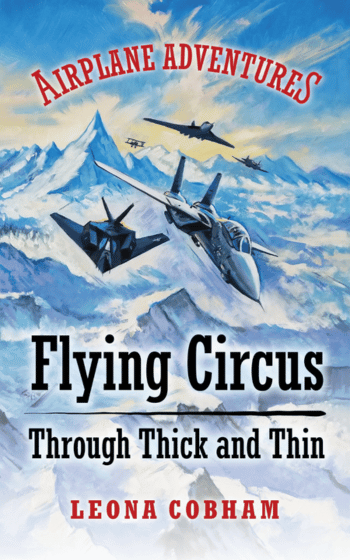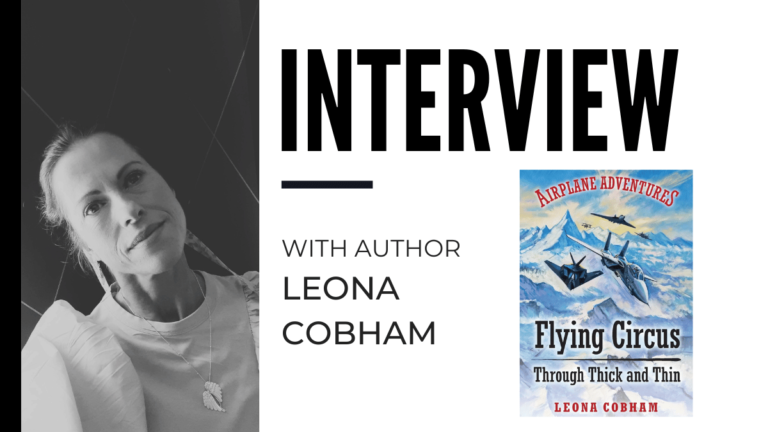This is an interview about Flying Circus Through Thick and Thin, a book that follows the adventures of four airplanes, presented in partnership* with Leona Cobham and The Children’s Book Review.
Prepare for takeoff into the wonderful world of Airplane Adventures with author Leona Cobham!
In this inspiring interview, Leona reveals how her grandfather, the pioneering aviator Sir Alan Cobham, helped spark her love for flight and storytelling. With aviation in her blood and a passion for nurturing young minds, Leona has created a series that soars with excitement, humor, and valuable life lessons. She shares how she brings her lovable airplane characters to life, seamlessly blending fascinating aviation facts with page-turning adventures.
Leona’s enthusiasm for storytelling and her dedication to empowering young readers shine through as she discusses her creative process, her collaboration with illustrator Timothy O’Brien, and the uplifting messages she hopes to convey. This interview offers a delightful glimpse into the joyful, educational world Leona has crafted, inviting readers of all ages to spread their wings and fly alongside her endearing characters.
Bianca Schulze: What inspired you to create a series of children’s books featuring anthropomorphic airplanes as the main characters?
Leona Cobham (LC): I realized this could be a perfect vehicle for creating adventure-filled plots which hold the attention of young readers, simultaneously incorporating some good scientific content while exploring life skills that are helpful for children: friendship, teamwork, and conflict resolution.
How has your family background, especially your grandfather, Sir Alan Cobham’s pioneering aviation work, influenced the stories you tell in the Airplane Adventures series?
LC: Aviation has always held positive associations for me. My grandfather was passionate about encouraging people to fly and enjoy flight. I grew up seeing aviation as thrilling and inspirational. I have adopted flight as a metaphor: inspiring young readers to get into the pilot’s seat in their own lives, to spread their wings, and fly.
The books include detailed aviation history and technical knowledge. How do you balance educating readers about these topics while keeping the story engaging and accessible for children?
I keep up the pace in the stories by maintaining suspense and having a pressing problem that must be solved. Cutting out unnecessary detail makes the stories easy to read. If there are readers who want more information, there is an illustrated glossary at the back of the books. I make sure the emotional challenges are ones children can relate to: coming back after making mistakes, asking for help without losing face, accepting different points of view. All this makes the stories relatable, and I believe that’s what engages readers.
You typically infuse your writing with humor, adventure, and a feel-good factor. Why do you believe these elements are essential in children’s literature?
LC: I think we learn best when we are having fun and when we feel safe. I do infuse humor into the stories because it’s comforting to laugh at life’s predicaments sometimes. We are not perfect, and my message to children is: ‘That’s ok!’. I create flawed, lovable characters because grasping the fact that we are lovable despite our flaws is fundamental to healthy child development.
The airplane characters in your series are endearing blends of heroic and flawed. Why was it important for you to create multi-dimensional characters that young readers could relate to?
I want to create scenarios where children can see how our individuality is a good thing. We each offer value in our own way. We don’t want a world where we are all good at the same thing and weak at the same thing! For example, Woody the little bi-plane, may be slow but he can land on unsurfaced runways which is a pretty handy little skill! It saves the team on a race to Australia in my first book. It also means he can fly slowly without stalling which enables him to guide the Chinook when the team are putting out a forest fire in the second book. All the characters are different, like we are. The message is to look at your unique characteristics and consider what value you can bring to any situation.
In Flying Circus Through Thick and Thin, the airplane characters face various challenges and learn valuable lessons. What key messages or morals do you hope young readers will take away from these stories?
LC: In the first story, Dangerous Elements, Tom the F-14 Tomcat, accidentally gives away the team’s radio frequency to a suspicious mining operation. He feels ashamed. But when there’s a snowstorm that endangers the super-stealthy Nighthawk F-117, he steps up. It takes great courage to put shame aside, but he does, and he then makes amends by using his exceptional navigational skills to bring the Nighthawk safely back to base. Through stories like these, young readers see that we all have gifts to bring to the table. We are all heroes on a journey.
A skill which I like to write about which has particular relevance these days is conflict resolution and accepting differences. It’s never easy to gracefully accept alternate points of view if they seem to threaten ours, is it? In a story called Hats Off to Spif, the Spitfire is challenged to tolerate an alternative take on an episode from history that’s close to his heart. Through his character arc in this story, my readers see how Spif’s flexibility doesn’t weaken him. In fact, his ability to keep calm and remain untriggered elevates him from fine leader to great leader.
At the start of the third story, the Flying Circus planes are a little disgruntled at an airshow by the popularity of a Chinook. When a forest fire breaks out, they reluctantly accept his help and then realize the value he brings to the team effort. We hear the Vulcan’s thoughts in the following passage:
Vul watched Chandon hovering over the water. “What a skillful aircraft he is, this Chinook. Bags of space inside, external buckets for firefighting, baskets for rescuing people from any environment you care to imagine. And he can maintain this stable hover in one place, for hours.” Vul listened to the thrum of Chandon’s rotors, his admiration growing. “It’s nice this feeling. Much better than feeling envious and bitter.”
The message is: we’re better together.
Can you tell us more about the process of collaborating with the illustrator to create vintage-style artwork and diagrams that complement the text?
LC: Working with Timothy O’Brien has been a dream. He has a great interest in aviation and is also a highly regarded aviation painter. So he brings this remarkable combination to the table. He liked my idea of a vintage look for the books using line-drawings when I first approached him. The way it works is I give him the manuscript and outline the scenes I would like depicted in the illustrations. Then he comes back to me with his preliminary sketches, and he nearly always gets it right first time. They are basically a manifestation of what I was seeing in my mind. We just work really well together because we seem to have a shared vision.
As the series progresses, how do you envision the characters and their relationships evolving? Will there be new additions to the cast of airplane friends?
LC: We have had visiting characters like Eel, the F-15 Eagle and Chandon, the Chinook. Nighthawk, the F-117, was the first female character to appear, and she will have a prominent role in Book 3. I don’t really try to ‘envision’ to be honest. It just happens. I guess that’s creative magic! The characters have lives of their own and all I can do is tell you what they told me.
Your experiences teaching in Brazil and working as a classroom reading assistant seem to have shaped your understanding of different learning styles. How has this influenced your approach to writing for children?
LC: Working with children from such a wide variety of backgrounds has confirmed for me that we each learn differently. But one thing that does inspire all of us is a sense of wonder. If we want to draw kids off their devices, we must provide thrills that compete with the excitement they get from the virtual world. So my books are packed with thrilling stuff. Fewer children are reading now than in any previous generation. We need to entice them back to reading.
I try to cover the visual learners with a plethora of clear diagrams, the contextual learners with background stories where they can see the technology in operation. For example, when Nighthawk gets lost, because she is a stealth plane, she has a very small radar return. This gives my reader a visual on how radar works. For those who can’t get enough information and love to research stuff, there’s plenty of information in the glossary section. I’ve made it easier by emboldening words in the text that are referenced in the glossary.
What advice would you give aspiring children’s authors who want to create engaging, educational, and entertaining stories like those in the Airplane Adventures series?
LC: Have a good plot! Hang your character arcs on that. A strong plot is centered on a dramatic question which must be answered throughout the course of the story. Every element of the plot exists in service to answering that question.
It also strengthens a series of stories if you tell each one with a clear POV (point of view). You can change the character who’s POV you are using from one story to another but be clear in your own mind whose POV it is. Try to get the characters to tell the story, and you, the narrator, get out of the way.
And finally, steer clear of giving neat summaries of emotions like ‘he was sad’. Rather provide a scene which takes your readers with the character, so the reader feels the emotions that are a consequence of the circumstances.
About the Book

Written by Leona Cobham
Illustrated by Timothy O’Brien
Ages 7+ | 144 Pages
Publisher: Cobham Wings | ISBN-13: 9781739407032
Publisher’s Book Summary: A group of anthropomorphized airplanes encounter extreme weather while training at a mountain base. The Spitfire and the biplane, Woody, discover a suspicious mining operation. Tom, the F-14, accidentally gives their radio frequency to the antagonists at the mine. A snowstorm causes more problems. Tom makes amends by rescuing an F-117 Nighthawk.
The second story is a comic tale of mistaken identity. Spif feels responsible for the smooth running of a historical commemoration, but his plans are hampered by a series of hilarious errors involving statues of Wellington and Napoleon.
In the final story, when the friends are invited to an air show in the height of summer they become impatient with a Chinook who is garnering attention. They take to the sky, and the Tomcat lights his afterburners. When a fire starts, he assumes it was his fault. He overcomes his shame to help with the firefight. Spif must put his pride aside and accept assistance from the popular Chinook. Each aircraft contributes to the effort with its own unique skill set. When they save some scouts who have been camping, it turns out it was the scouts who started the fire. They realize through making mistakes, we learn.
Buy the Book
About the Author
Leona was immersed in the world of aviation from a young age; her grandfather, Sir Alan Cobham, made many first-time flights as well as pioneering the invention of air-to-air refueling. Leona absorbed this love of flying and travel. While working in a forest recuperation project in Brazil, Leona volunteered to teach in a shanty town. Here, a lifelong interest in understanding different learning styles began. On return to the UK, she began to write children’s fiction and worked part-time as a classroom reading assistant. Believing happy children learn best, Leona infuses her writing with humor, adventure, and a big feel-good factor. Her endearing characters overcome personal as well as technical challenges to succeed.
For more information, visit: www.cobhamwings.co.uk

This interview—An Interview with ‘Flying Circus Through Thick and Thin’ Author Leona Cobham —was conducted between Leona Cobham and Bianca Schulze.
*Disclosure: Please note that this post may contain affiliate links that share some commission. Rest assured that these will not affect the cost of any products and services promoted here. Our team always provides their authentic opinion in all content published on this site.



